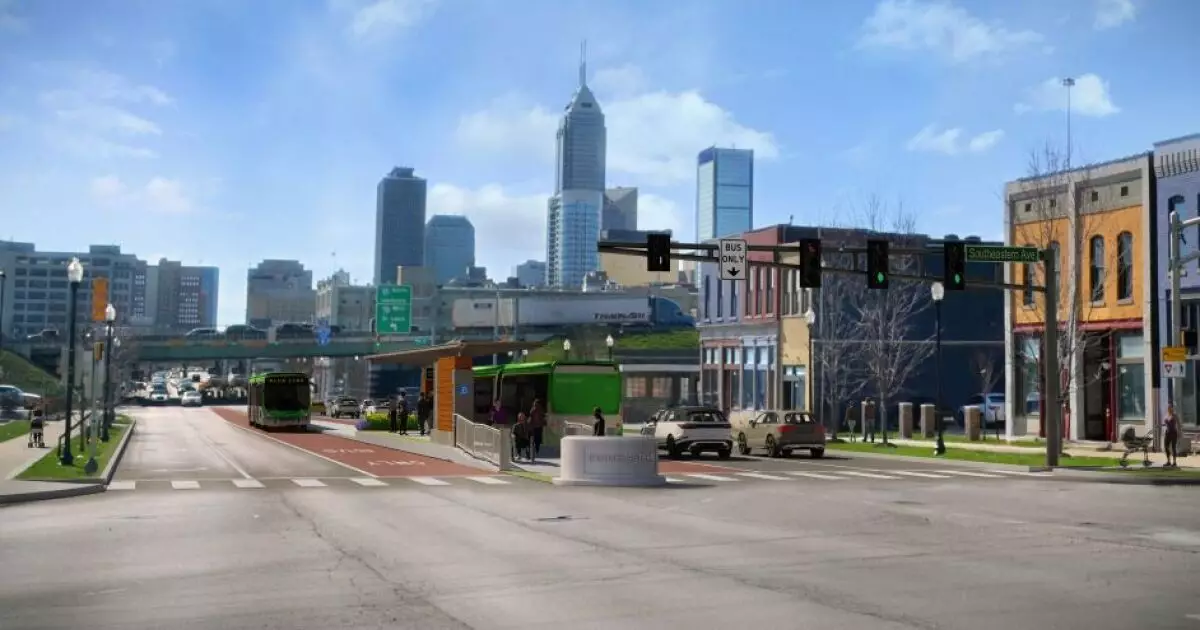In a long-awaited move, Indianapolis is gearing up for a transformative $125 million bond sale aimed at enhancing public transportation through an innovative bus rapid transit (BRT) project. While the plan is ambitious—connecting the Indianapolis International Airport to downtown and extending to the eastern fringes of Marion County—it’s also indicative of a more significant, often overlooked necessity for city dwellers. The Indianapolis Public Transportation Corporation, or IndyGo, has engaged the Indianapolis Local Public Improvement Bond Bank to facilitate this venture, yet skeptics must ponder whether this investment will yield the desired results amidst ongoing financial uncertainties.
Certainly, the $125 million bond sale has garnered attention, especially with S&P Global Ratings assigning an AA-minus rating and acknowledging a stable outlook. However, the financial market’s erratic nature poses questions regarding market timing. Joe Glass, the executive director of the bond bank, acknowledged the unpredictability, indicating their decision to postpone pricing was a prudent move. This underscores a critical point: adaptability in financial undertakings—especially when public funds are at stake—should guide the investment, rather than impulsive decision-making.
A Complex Web of Funding and Financial Security
The BRT project isn’t merely a transportation upgrade; it’s a financial juggernaut that entwines various funding mechanisms, primarily relying upon local income tax revenues from Marion County residents. This reliance provokes fundamental questions about fiscal responsibility. While a special ordinance pledging these tax revenues seems to promise robust support for principal and interest payments, history has shown that reliance on consistent revenue flows can be misleading.
Even though S&P Ratings applauds IndyGo’s strong financial metrics, with a promising analysis of revenue growth from local income taxes, one cannot ignore the potential downsides. The tax initiative, which has a coverage ratio of 3.5x for annual debt service, appears solid at first glance. The underlying assumption, however, is that economic conditions remain stable. What if a downturn occurs? Will the revenue from Marion County’s local income tax hold steady when citizens face economic strife? This bet on anticipated future revenues requires careful contemplation, as economic conditions could shift unpredictably.
Furthermore, the issuance of bonds can often lead to burdensome debt, especially if it is not effectively managed. After this bond issue, IndyGo will be saddled with $209.1 million in long-term debt. Readers must grapple with whether this is a prudent decision or an overreach driven by political motivations. Will the benefits for the average commuter outweigh the long-term financial commitments that the city undertakes?
Transitioning from Planning to Practical Implementation
On February 28, IndyGo held a ceremonial groundbreaking for the Blue Line BRT, enthusiastically heralding a new chapter in public transportation. However, ceremonies alone don’t ensure success. The BRT is poised to feature 36 new bus stations and emulate light rail efficiencies—but this intent alone does not guarantee that citizens will perceive it as a tangible improvement. Effectively, the project aims to offer a better solution in a cost-effective manner, yet getting past the “if you build it, they will come” mindset is crucial.
The post-pandemic reality further complicates matters. The recovery of ridership is crucial for assessing the efficacy of this new infrastructure, yet it is returning at a lethargic rate—about 75% of pre-pandemic levels. The farebox recovery ratio, hanging around 5% of total revenues, reveals a significant reduction from the projected figures in 2019, indicating that simply improving infrastructure won’t suffice in a ticket-based economy. What measures will be taken to ensure that commuters return once new transit options become available?
Investing in public transit must align with a much broader strategy that not only upgrades infrastructure but also re-engages the community and builds trust in the system. A more compelling outreach strategy could attract former riders and ensure that new constituencies see public transportation as a genuine alternative to single-occupancy vehicles.
Looking Ahead: A Call for Reflection and Accountability
As Indiana prepares for this crucial development in public transit, citizens should be compelled to ask difficult questions. Is this massive financial undertaking a necessary evolution of our transportation system, or merely a politically convenient project designed to buy favor? The consensus around the benefits of a BRT system must come with rigor and caution, or Indianapolis may find itself trapped in a cycle of debt without the corresponding ridership to justify its existence.
Long-term viability and success hinge on public accountability and transparency in decision-making. Citizens should advocate for ongoing assessments of the project to ensure that it meets the pressing needs of the community rather than serving interests that may not be aligned with everyday transit users. Through vigilance and strategic thinking, perhaps IndyGo can fulfill not just the promises of improved public transport but also pave the way for a greener, more connected city.

